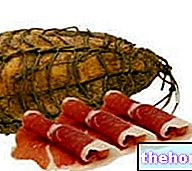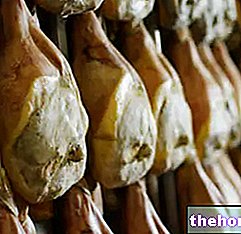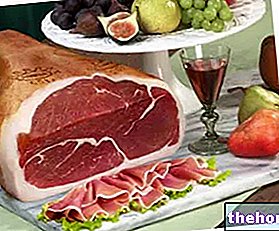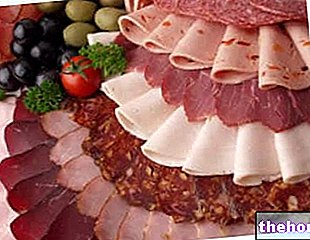In gastronomy, the term bacon it contains more than one meaning, even if all refer to a meat preparation deriving from the belly of the pig (swine). The noun "pancetta" can therefore refer to:
- Bacon preserved:
- Rolled bacon, with or without rind, stuffed or not stuffed, smoked or unsmoked (it is a cured meat)
- Bacon, smoked or unsmoked, sliced or diced (salted, flavored and possibly smoked meat - it is also an ingredient in sauces for pasta dishes, savory pies, etc.)
- Bacon (pre-cooked and smoked meat)
- Fresh bacon (whole, sliced - it is both an ingredient and a dish in its own right).

Bacon preserved
Preserved pancetta is an extremely popular product obtained from the meat of the fresh pork belly. It is white (fat) with more or less important streaks of muscle (red or brown); the fat of the smoked bacon takes on a yellowish color.
Production: we start with the squaring, trimming and possible skinning of the fresh pancetta which, immediately after, is salted, flavored and spiced (black pepper and sometimes rosemary, cloves, nutmeg, fennel seeds, etc.); the pancetta it is then left to rest for a few days. The procedure that follows varies according to the type of product to be obtained:
- Rolling, with or without rind; if without rind, the pancetta must be stuffed into a natural or synthetic casing and then tied. The one prepared in the territory of Carnia requires a greater salting than the other regional recipes; the Friulian-manicata pancetta is prepared by salting in superimposed layers , spicing it and stuffing it inside a particular casing called seasoned sleeve. Pancetta with loin is produced WITHOUT rind but by adding "fillets" of loin to the inside; it is then rolled up on itself, stuffed and seasoned.
- Splinting, with the rind; the bacon is folded and pressed between two boards tied together.
- No other procedures; the stretched pancetta is simply left to mature with the rind.
Lastly, the curing process takes place which lasts from 50 to 120 days, depending on the size; the rolled pancetta with loin faces a long seasoning of up to 10 months.
Pancetta with COTENNA can also be exempted from seasoning, as long as it undergoes an "appropriate smoking through the use of specific smokehouses; moreover, the stretched pancetta can be subjected to "dicing" and marketing in a box even without seasoning or smoking.
Bacon is an extremely widespread preparation in Anglo-Saxon countries, China and Korea; it is nothing more than pre-cooked steamed and subsequently smoked fresh pancetta.
Fresh bacon
Fresh bacon is the unpreserved belly of the pig. It is an absolutely widespread dish in all countries that traditionally consume pork and represents a progenitor of the "grilled pork", an absolutely widespread recipe typical of areas with a continental rather than Mediterranean climate (north and north-east).
The cooking method par excellence for pancetta is "grilled on the grill" and with embers; through a similar treatment, fresh bacon has the ability to dissolve and drain significant amounts of fat, losing a good amount of excess calories. On the other hand, what many ignore is that the weight loss of fresh toasted bacon is NOT directly proportional to that of the lipids contained in it since, in addition to these, there is a certain level of dehydration (loss of water). Furthermore, the negative implications of grilling should also be carefully considered, namely the over-production of toxic and carcinogenic compounds such as polycyclic aromatic hydrocarbons.
Bacon: hygiene and additives
The pig is an animal potentially at risk of Toxoplasma type parasitosis, an organism that can infect humans and cause irreversible damage to the fetus of pregnant women. For this reason, preserved bacon (except bacon) is an UNSUITABLE food for the " nutrition of the pregnant woman who, from a hygienic point of view, could alternatively consume well-cooked fresh bacon.
The "commercial" preserved pancetta is characterized by a particularly "lively" color of the muscle streaks, while the home-made pancetta browns quickly. This difference is determined by the presence or absence of sodium nitrate in the meat which, if on the one hand it keeps the color of the industrial product unaltered, on the other hand it is perceived with disgust on the palate of connoisseurs (not to mention the carcinogenic potential which, if in excess, it could manifest on man).
Nutritional characteristics
Preserved pancetta is an extremely fatty food, therefore high in calories, rich in cholesterol and sodium chloride. It is absolutely contraindicated to the diet of the obese, the one against hypercholesterolemia and also in the diet for hypertension.
Preserved bacon has no noteworthy concentrations of vitamins or mineral salts.
In a balanced diet, pancetta must play at least a marginal role; sporadic consumption frequency and moderate portions are recommended.
Nutritional values (per 100 g of edible portion)
INRAN Food Composition Tables


Other Foods - Cured Meats and Sausages Bresaola Cotechino Culatello Guanciale Sausages Lard Mortadella Bacon Raw Ham Cooked Ham Ham Spanish Ham Salami Sausage Blood Pudding Speck Wurstel Zampone OTHER ARTICLES SALAMI Categories Alcoholic Food Meat Cereals and derivatives Sweeteners Sweets Offal Dried fruit Legs and Derivatives Milk and Derivatives Fish and fishery products Cured meats Spices Vegetables Health recipes Appetizers Bread, Pizza and Brioche First courses Second courses Vegetables and Salads Sweets and Desserts Ice creams and sorbets Syrups, liqueurs and grappa Basic Preparations ---- In the kitchen with leftovers Carnival recipes Christmas recipes Light diet recipes Women's, mom's and dad's day recipes Functional recipes International recipes Easter recipes Celiac recipes Diabetic recipes Holiday recipes Valentine's Day recipes Vegetarian recipes Protein recipes Regional recipes Vegan recipes




























